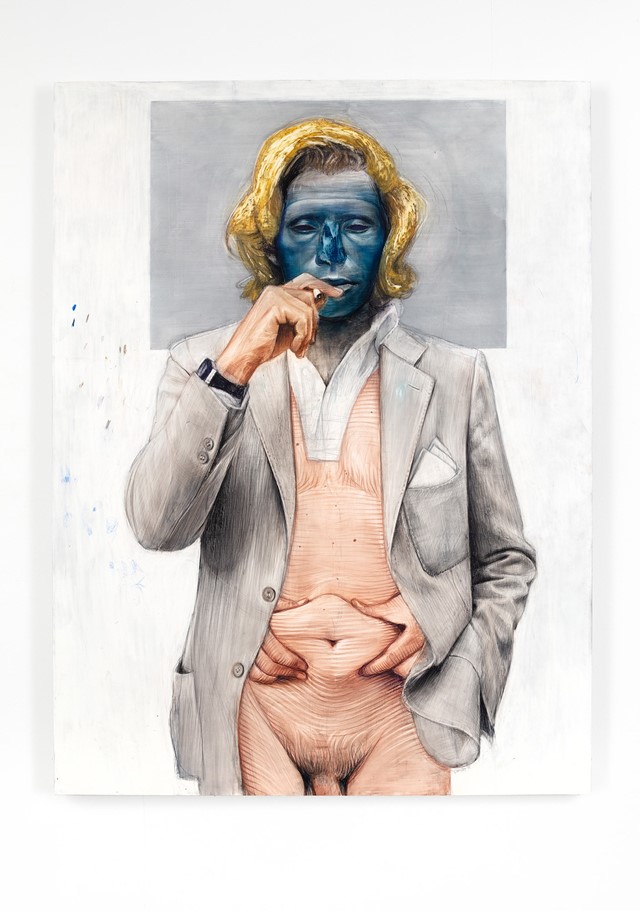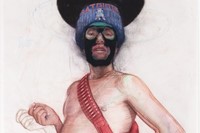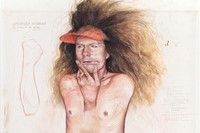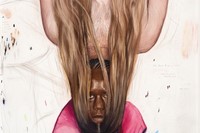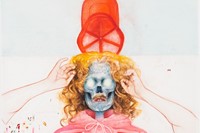The American artist discusses his new series of drawings on show at Jack Shainman Gallery in New York City
Gender melancholia is an idea that underpins a new series of larger-than-life watercolour pencil drawings by the Philadelphia-born, Brooklyn-based artist Geoffrey Chadsey, currently on show at Jack Shainman Gallery in New York City. It’s a concept that comes from Judith Butler, who, building on Sigmund Freud’s discussion of melancholy in Mourning and Melancholia, proposes that “gender itself is a melancholic identification in which the same-sex parent one is not allowed to desire, and who is thus lost as a love object, is internalised or incorporated”. Without wanting to delve too much into Butler’s philosophy and gender theory, and to give a very brief, probably wildly reductive summation, it’s about how gender, sexuality, love, loss and desire come together to form a potent and very gay cocktail of sadness. (Forgive me, Judith.)
It’s this cocktail that Chadsey explores through his towering, almost totemic drawings. Depicting men’s bodies, split and spliced, soft and sensual – though not sexual – these drawings toe the line between the mysterious and the monstrous; almost like religious icons, but with a sense of the depraved, they loom over the view, gazing and being gazed at. The exhibition’s title, Plus, nods to the Virus That Shall Not Be Named, ie testing positive, as well as the state of being positive. It also speaks of being a plus-one, specifically the idea of a son being a father’s plus-one – Chadsey’s own father passed away last year and he describes him as the “the unspoken audience” for much of this work; his father appears in one of the drawings, in memorial to a man who he loved but had a complicated relationship with.
Here, speaking in his own words, the artist tells AnOther more about this series and the themes he explores in it.
“[My drawings are] psychologically fraught; they come from a very emotionally ambivalent place. I was concerned that they were going to be these negative, knotty [works]. And so I definitely called [the exhibition] Plus in order to counteract [that] … And then my father died and I was also thinking about being his plus-one, in the sense of a son being a father’s plus-one … he was great but he’s also someone I constantly struggled with. I feel like he was the unspoken audience for a lot of this work.
“Growing up gay in Virginia, I used to draw women [as] princesses; these nine-foot-tall girls with very elaborate, frilly skirts. My parents loved it. I would draw all the time. But then my mother was like, why is he only drawing women? It wasn't even an accusation but my first thought in my head was like, fuck, I need to cover my tracks. So I started putting these obligatory, like, escorts, this one man, to be like, look, I’m drawing men too. Well now of course the joke is [that] the women have been completely exorcised and I’m drawing that one man – over and over and over again. And somehow he's absorbed all the women too.
“There’s this pose I keep returning to, like Gustav Klimt’s Judith: looking down your nose; the hooded eyes – it’s such a rock and roll pose. There’s something very alluring and judgmental about it; there’s eye contact, but also this kind of distance. It’s something I’ve returned to over and over again. I also have this archive of drunk guys who used to be in Google – now there are all these firewalls, but before if you typed the word ‘drunk’ into Google, you would get all these images of drunk, 20-year-old assholes enacting these kinds of homoerotic poses.
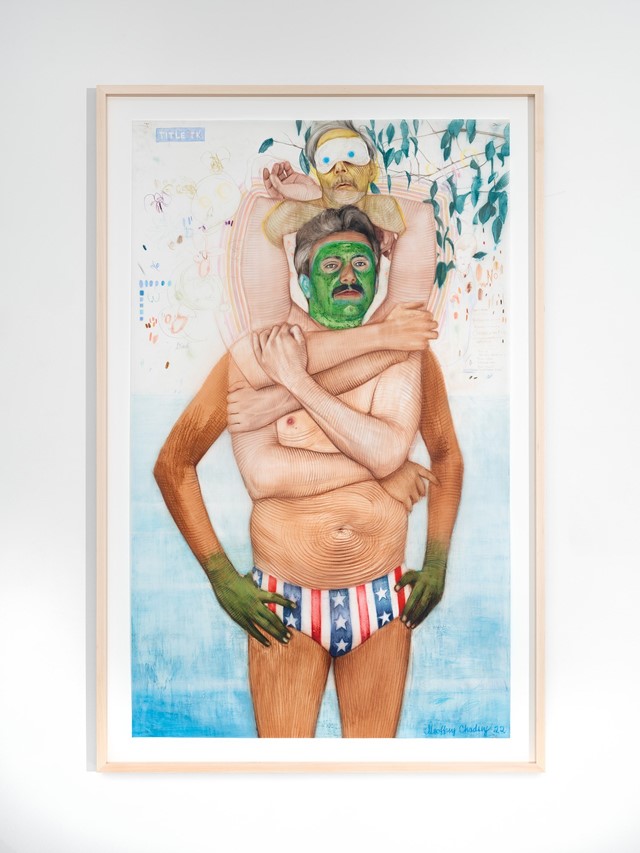
“But I feel like the sexuality has been stripped away from [the nudity in these drawings], in the sense that they’re not necessarily alluring; they’re somehow vulnerable. I also feel like there’s something funny about, like, this guy somehow trying to shape his body in a certain way, this kind of violent act, that’s almost a joke about working out too. Like, ‘This body is going to a certain shape goddammit.’ And there’s something about an older, white male body on top of this woman’s head – a kind of funny ambivalence about it.
“It’s been interesting to walk around and listen to people. I want people to look at [these drawings] and say ‘Jesus Christ, what is that?’, but also for them to say ‘wow’. I want to create an almost religious spectacle. That’s the great thing about monsters in films: they‘re repulsive and yet you’re drawn to them in this unconscious or maybe conscious identification with them. It’s like, they’re kind of getting away with something you would like to get away with. Of course, in the end, they’re put back in the box or killed or whatever. I don’t think that these creatures are monster-monsters, but there is something monstrous about them.
“I had a show here in 2005 and as [my father] was walking in I was like, ‘There’s a drawing of you in the show’. It was him lying in a field of ivy and there was this naked, possibly dead adolescent kid. My dad stood next to the drawing all night talking to people. So I was like, I’m going to try and draw him again and see if I have a different reaction to him. It ended up being a memorial piece. But I felt like it was such a dutiful son thing to do. I felt guilty drawing his sick self, but at the same time, that’s who he is in my memory and I’m acknowledging who I saw in the bed – I wasn’t sure if it was going to come out comic or heroic. It was a hard one for me to finish. But it’s the only one I signed.”
Geoffrey Chadsey: Plus is at Jack Shainman Gallery, New York City, until 18 June 2022.
